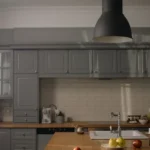Painting your kitchen cabinets

- Sanding Paper
- Primer Paint
- Paint Brushes and Rollers
- Tack Cloth
- Drop Cloth
- Paint thinner
- Alkyd Based Enamel Paint
- TSP
- Screwdriver
- Pick the ideal moment.
Pick a week when the temperatures are expected to be comfortable. A hot climate should be avoided since it will cause the paint to dry before it can entirely level itself, resulting in ridges that are formed by the bristles of the brush.
- Clear the space.
You need to clear out the cupboards, drawers, the tabletop, and the shelves in your home. Take advantage of the opportunity to get rid of things you rarely use.
- Close off the area around the kitchen.
If it appears that the project will require a significant amount of sanding, hang several sheets of plastic that overlap each other over the entrance to the kitchen. This will prevent sanding dust from spreading throughout the rest of the house.
- Give the cupboards a thorough cleaning.
Applying a solution made of TSP and water to the cabinet frames, doors, and drawers allows for a thorough cleaning. Pay special attention to the cabinets that are located around the stove. You are going to be astounded to see how much grease has built up in the various nooks and crannies of the cabinet doors.
- Remove doors, drawers, and hardware.
Using your screwdriver, remove all the hardware, doors and drawers.
Do not deceive yourself into thinking that you can do something professional if you do not complete this step. Keeping track of which cabinet doors and drawers belong in which locations can make the re-installation process much simpler, so be sure to record this information.
- Sand all of the surfaces.
Using paper with a grit of 220, lightly sand all of the surfaces that will be painted. This pertains to both sides of the doors, as well as the fronts of the drawers, rails, and stiles. Once you’ve sanded all surfaces, wipe them down to ensure smooth surface.
- Apply the primer.
If your cabinets are stained, you need to prime them with at least two coats of a good quality primer, this will ensure that it dries quickly and evenly, without leaving any brush marks.
- Water down your alkyd paint.
Follow the directions on the can of alkyd-based enamel paint to add a thinner to it. If you don’t want your brush strokes to show, don’t use water-based paint.
- Apply the paint finish.
The backs of the cabinet doors should be painted first. Do the fronts last because drips are less likely to ruin them. Paint with the wood’s grain. Let the paint fully dry before turning the doors (or drawers) over and painting the other sides. Keep an eye out for paint dripping and building up in cracks.
- Reinstall
In the final step, reinstall the doors and drawers, as well as the hinges and catches. Then proceed to install the new handles or knobs on the drawers and doors.

